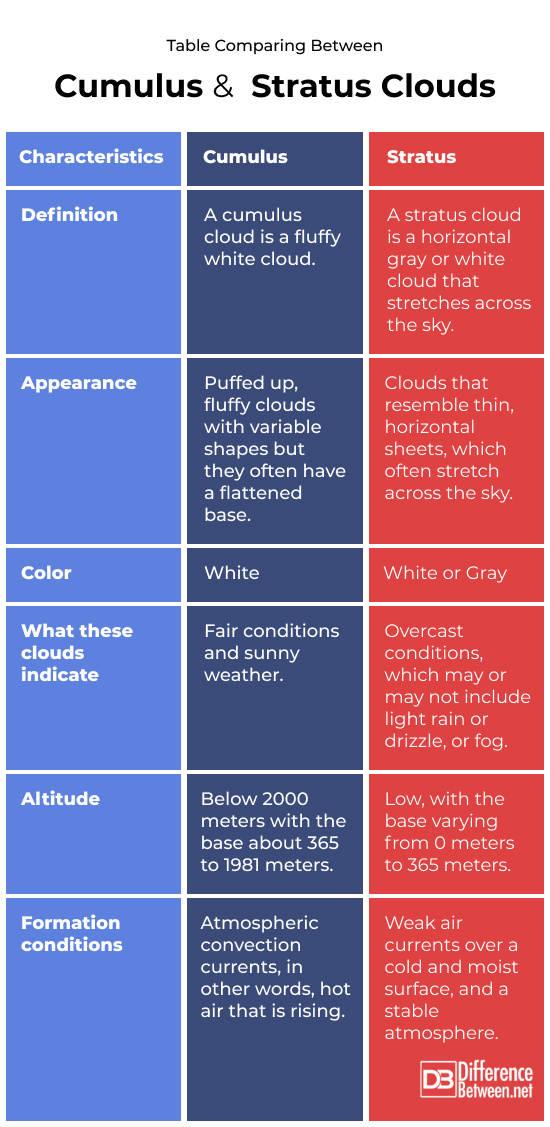Difference Between Cumulus and Stratus Clouds
Cumulus clouds appear singly in the sky as puffy white clouds. Stratus clouds are wide continuous sheets that are white or gray.

What are Cumulus clouds?
Definition:
Cumulus clouds are fluffy clouds that occur individually at low levels of the atmosphere.
Formation:
The cumulus clouds are formed by convection. In other words, as air is heated it rises and condenses into water vapor. These clouds are formed low down in the atmosphere but can develop into larger storm clouds called cumulonimbus clouds on very hot days. Cumulus clouds form when there is a shallow level of atmospheric instability.
Properties of cumulus clouds:
Cumulus clouds are of variable shapes although they have a flattened bottom area. These clouds look like heads of cauliflower or cotton balls suspended in the air. They occur individually and not continuously. These clouds will be seen dotting a blue sky and occur when the atmosphere is quite stable. Further convection may change the atmosphere leading to instability and the development of cumulonimbus clouds from the cumulus clouds.

What are Stratus clouds?
Definition:
Stratus clouds are wide sheets of clouds that are found at low altitudes in the atmosphere.
Formation:
These clouds develop when there are stable conditions and from air flowing over a moist, colder land mass. This causes condensation in the air at low levels, sometimes so low that fog is actually produced. It is easy to confuse mist and fog. Mist is when there is a temperature inversion while fog is actual stratus cloud that is resting on the ground or very close to the ground.
Properties of stratus clouds:
These are horizontal clouds that occur in layers that often span the whole sky. They can be white or gray in color and are often seen on overcast days. These types of clouds can make for a depressing day because they are so wide, it often means you do not see much or any blue sky and sun.
Difference between Cumulus and Stratus clouds?
Definition
A cumulus clouds is a white, fluffy cloud. A stratus cloud is a white or gray horizontal cloud.
Appearance
Cumulus clouds are fluffy clouds that look puffed up. The shape can vary but they do have a flat base. Stratus clouds are thin, flat, horizontal sheets.
Color
The color of cumulus clouds is white. The color of stratus clouds varies from white to gray.
What these clouds indicate
Cumulus clouds indicate fair conditions. Stratus clouds indicate overcast conditions with a chance of fog, or drizzle.
Altitude
The elevation at which you find cumulus clouds is below 2000 meters with the base of the clouds sitting at anywhere between 365 to 1981 meters. Stratus clouds can be found from ground level all the way up to 365 meters.
Formation conditions
Cumulus clouds are produced because of convection currents. Stratus clouds are produced when air flows over cool, moist land where there are weak currents but the atmosphere is stable.
Table comparing between Cumulus and Stratus clouds

Summary of Cumulus Vs. Stratus clouds
- Cumulus clouds are fluffy and look like cauliflower heads.
- Cumulus clouds occur individually in the sky and are often surrounded by blue sky and sun.
- Stratus clouds are typical of days that are overcast with no to little blue sky evident.
- Stratus clouds are thin, flat blankets or sheets, that spread across the sky.
- Both cumulus and stratus clouds occur at lower atmospheric altitudes but while stratus may produce drizzle, cumulus clouds do not produce precipitation.
FAQ
What are 3 differences between cumulus and stratus clouds?
Cumulus clouds have a flattened bottom, variable shape, and occur individually in the sky. Stratus clouds look like sheets or blankets and are wide, and flat clouds that can cover the entire sky.
What is the difference between cirrus cumulus and stratus clouds?
Cirrus cumulus clouds are thin clouds that look like they have curls. These clouds are also found at much higher elevations than are stratus clouds. Stratus clouds are simply flat sheets of clouds that are found at low elevations in the sky.
What is the difference between stratus cumulus and cumulonimbus clouds?
Stratus cumulus clouds are grey and flat while cumulonimbus are large vertical, towering clouds. The cumulonimbus clouds appear when a thunderstorm is likely, and often they take on an anvil shape at the top of the cloud. These clouds that have an anvil are known more specifically as cumulonimbus incus clouds.
What is the difference between cumulus and stratiform clouds?
Stratiform clouds occur in layers and stretch horizontally across the sky. Cumulus clouds occur as individual clouds that have a flat base but variable top part. They do not stretch all the way across the sky the way that stratiform clouds do.
What are 3 characteristics of stratus clouds?
These clouds look like sheets, they are wide, flat, and do not show any other features. They may be white or gray.
What are 2 characteristics of cumulus clouds?
Cumulus clouds have a flat base, they often look like cotton balls, and are white.
- Difference Between Rumination and Regurgitation - June 13, 2024
- Difference Between Pyelectasis and Hydronephrosis - June 4, 2024
- Difference Between Cellulitis and Erysipelas - June 1, 2024
Search DifferenceBetween.net :
Leave a Response
References :
[0]Encyclopedia Britannica. “Troposphere”. Encylopedia Britannica, 2023, https://www.britannica.com/science/atmosphere/Troposphere#ref952886
[1]Funk, Ted. “Cloud classifications and characteristics”. National Weather Service, 2023, https://www.weather.gov/media/lmk/soo/cloudchart.pdf
[2]Met Office. “Cumulus clouds”. Crown, 2023, https://www.metoffice.gov.uk/weather/learn-about/weather/types-of-weather/clouds/low-level-clouds/cumulus
[3]Image credit: https://www.canva.com/photos/MADAoFsIOMA-stratus-cloud-sky/
[4]Image credit: https://www.canva.com/photos/MAD3yKrjylA-cumulus-clouds/
